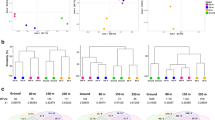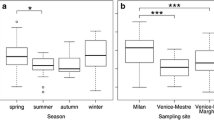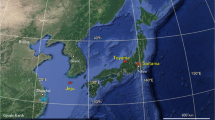Abstract
Airborne bacteria could affect human health and climate. In this study, the bacterial community structures were investigated by analyzing air samples collected from a suburban location in Toyama, central Japan. Sixty samples were collected almost weekly between March 2009 and February 2010. A cultivation-independent approach, PCR plus denaturing gradient gel electrophoresis (DGGE), was used to analyze changes in the structure of the airborne bacterial communities. The DGGE profiles showed significant differences between sampling days, reflecting quite different bacterial profiles. Sequencing of DGGE bands revealed that the bacterial community was dominated by γ-Proteobacteria, Firmicutes, α-Proteobacteria, Bacteroidetes, and Actinobacteria. The most frequently observed genus was Pseudomonas, followed by Bacillus. The airborne bacterial assemblage in winter differed from that in the other seasons. The differences could be attributed a number of factors, such as temperature, relative humidity, wind direction, and snowfall. In spring, the largest number of bands was classified as plant chloroplasts, such as Japanese cedar (Cryptomeria japonica) and Pinus spp., which are the major pollen allergen sources in Japan. The airborne bacterial abundance estimated by real-time TaqMan PCR ranged from 1.1 × 103 to 1.3 × 105 cells m−3.



Similar content being viewed by others
References
Bertolini, V., Gandolfi, I., Ambrosini, R., Bestetti, G., Innocente, E., Rampazzo, G., et al. (2013). Temporal variability and effect of environmental variables on airborne bacterial communities in an urban area of Northern Italy. Applied Microbiology and Biotechnology, 97, 6561–6570.
Blanchard, D. C., & Syzdek, L. D. (1982). Water-to-air transfer and enrichment of bacteria in drops from bursting bubbles. Applied and Environmental Microbiology, 43, 1001–1005.
Bowers, R. M., McCubbin, I. B., Hallar, A. G., & Fierer, N. (2012). Seasonal variability in airborne bacterial communities at a high-elevation site. Atmospheric Environment, 50, 41–49.
Bowers, R. M., McLetchie, S., Knight, R., & Fierer, N. (2011). Spatial variability in airborne bacterial communities across land-use types and their relationship to the bacterial communities of potential source environments. The ISME Journal, 5, 601–612.
Brodie, E. L., DeSantis, T. Z., Parker, J. P. M., Zubietta, I. X., Piceno, Y. M., & Andersen, G. L. (2007). Urban aerosols harbor diverse and dynamic bacterial populations. Proceedings of the National Academy of Sciences of the United States of America, 104, 299–304.
Burrows, S. M., Elbert, W., Lawrence, M. G., & Pöschl, U. (2009). Bacteria in the global atmosphere – Part 1: Review and synthesis of literature data for different ecosystems. Atmospheric Chemistry and Physics, 9, 9263–9280.
Christner, B. C., Cai, R., Morris, C. E., McCarter, K. S., Foreman, C. M., Skidmore, M. L., et al. (2008). Geographic, seasonal, and precipitation chemistry influence on the abundance and activity of biological ice nucleators in rain and snow. Proceedings of the National Academy of Sciences of the United States of America, 105, 18854–18859.
Claesson, M. J., Wang, Q., O’Sullivan, O., Greene-Diniz, R., Cole, J. R., Ross, R. P., et al. (2010). Comparison of two next-generation sequencing technologies for resolving highly complex microbiota composition using tandem variable 16S rRNA gene regions. Nucleic Acids Research, 38, e200.
Fahlgren, C., Bratbak, G., Sandaa, R. A., Thyrhaug, R., & Zweifel, U. L. (2011). Diversity of airborne bacteria in samples collected using different devices for aerosol collection. Aerobiologia, 27, 107–120.
Fahlgren, C., Hagström, A., Nilsson, D., & Zweifel, U. L. (2010). Annual variations in the diversity, viability, and origin of airborne bacteria. Applied and Environmental Microbiology, 76, 3015–3025.
Fannin, K. F., Vana, S. C., & Jakubowski, W. (1985). Effect of an activated sludge wastewater treatment plant on ambient air densities of aerosols containing bacteria and viruses. Applied and Environmental Microbiology, 49, 1191–1196.
Fierer, N., Liu, Z., Rodríguez-Hernández, M., Knight, R., Henn, M., & Hernandez, M. T. (2008). Short-term temporal variability in airborne bacterial and fungal populations. Applied and Environmental Microbiology, 74, 200–207.
Franzetti, A., Gandolfi, I., Gaspari, E., Ambrosini, R., & Bestetti, G. (2011). Seasonal variability of bacteria in fine and coarse urban air particulate matter. Applied Microbiology and Biotechnology, 90, 745–753.
Gao, B., Mohan, R., & Gupta, R. S. (2009). Phylogenomics and protein signatures elucidating the evolutionary relationships among the Gammaproteobacteria. International Journal of Systematic and Evolutionary Microbiology, 59, 234–247.
Griffin, D. W., Garrison, V. H., Herman, J. R., & Shinn, E. A. (2001). African desert dust in the Caribbean atmosphere: Microbiology and public health. Aerobiologia, 17, 203–213.
Gupta, R. S., & Lorenzini, E. (2007). Phylogeny and molecular signatures (conserved proteins and indels) that are specific for the Bacteroidetes and Chlorobi species. BMC Evolutionary Biology, 7, 71.
Gupta, R. S., & Mok, A. (2007). Phylogenomics and signature proteins for the alpha proteobacteria and its main groups. BMC Microbiology, 7, 106.
Haakensen, M., Dobson, C. M., Deneer, H., & Ziola, B. (2008). Real-time PCR detection of bacteria belonging to the Firmicutes Phylum. International Journal of Food Microbiology, 125, 236–241.
Hanning, I. B., & Ricke, S. C. (2011). Prescreening of microbial populations for the assessment of sequencing potential. Methods in Molecular Biology, 733, 159–170.
Harms, G., Layton, A. C., Dionisi, H. M., Gregory, I. R., Garrett, V. M., Hawkins, S. A., et al. (2003). Real-time PCR quantification of nitrifying bacteria in a municipal wastewater treatment plant. Environmental Science and Technology, 37, 343–351.
Harrison, R. M., Jones, A. M., Biggins, P. D. E., Pomeroy, N., Cox, C. S., Kidd, S. P., et al. (2005). Climate factors influencing bacterial count in background air samples. International Journal of Biometeorology, 49, 167–178.
Jaenicke, R. (2005). Abundance of cellular material and proteins in the atmosphere. Science, 308, 73.
Jeon, E. M., Kim, H. J., Jung, K., Kim, J. H., Kim, M. Y., Kim, Y. P., et al. (2011). Impact of Asian dust events on airborne bacterial community assessed by molecular analyses. Atmospheric Environment, 45, 4313–4321.
Jones, A. M., & Harrison, R. M. (2004). The effects of meteorological factors on atmospheric bioaerosol concentrations—A review. Science of the Total Environment, 326, 151–180.
Klappenbach, J. A., Saxman, P. R., Cole, J. R., & Schmidt, T. M. (2001). rrndb: The ribosomal RNA operon copy number database. Nucleic Acids Research, 29, 181–184.
Kuske, C. R. (2006). Current and emerging technologies for the study of bacteria in the outdoor air. Current Opinion in Biotechnology, 17, 291–296.
Lee, S., Choi, B., Yi, S. M., & Ko, G. (2009). Characterization of microbial community during Asian dust events in Korea. Science of the Total Environment, 407, 5308–5314.
Lee, S. H., Lee, H. J., Kim, S. J., Lee, H. M., Kang, H., & Kim, Y. P. (2010). Identification of airborne bacterial and fungal community structures in an urban area by T-RFLP analysis and quantitative real-time PCR. Science of the Total Environment, 408, 1349–1357.
Li, K. (2011). Molecular comparison of the sampling efficiency of four types of airborne bacterial samplers. Science of the Total Environment, 409, 5493–5498.
Li, K., Dong, S., Wu, Y., & Yao, M. (2010). Comparison of the biological content of air samples collected at ground level and at higher elevation. Aerobiologia, 26, 233–244.
Maki, T., Susuki, S., Kobayashi, F., Kakikawa, M., Tobo, Y., Yamada, M., et al. (2010). Phylogenetic analysis of atmospheric halotolerant bacterial communities at high altitude in an Asian dust (KOSA) arrival region, Suzu City. Science of the Total Environment, 408, 4556–4562.
Marcos, C., Rodriguez, F. J., Luna, I., Jato, V., & González, R. (2001). Pinus pollen aerobiology and clinical sensitization in northwest Spain. Annals of Allergy, Asthma & Immunology, 87, 39–42.
Maron, P. A., Mougel, C., Lejon, D. P. H., Carvalho, E., Bizet, K., Marck, G., et al. (2006). Temporal variability of airborne bacterial community structure in an urban area. Atmospheric Environment, 40, 8074–8080.
Matthias-Maser, S., Obolkin, V., Khodzer, T., & Jaenicke, R. (2000). Seasonal variation of primary biological aerosol particles in the remote continental region of Lake Baikal/Siberia. Atmospheric Environment, 34, 3805–3811.
Muyzer, G., de Waal, E. C., & Uitterlinden, A. G. (1993). Profiling of complex microbial populations by denaturing gradient gel electrophoresis analysis of polymerase chain reaction-amplified genes coding for 16S rRNA. Applied and Environmental Microbiology, 59, 695–700.
Muyzer, G., & Smalla, K. (1998). Application of denaturing gradient gel electrophoresis (DGGE) and temperature gradient gel electrophoresis (TGGE) in microbial ecology. Antonie van Leeuwenhoek, 73, 127–141.
Muyzer, G., Teske, A., Wirsen, C. O., & Jannasch, H. W. (1995). Phylogenetic relationships of Thiomicrospira species and their identification in deep-sea hydrothermal vent samples by denaturing gradient gel electrophoresis of 16S rDNA fragments. Archives of Microbiology, 164, 165–172.
Neale, D. B., & Sederoff, R. R. (1989). Paternal inheritance of chloroplast DNA and maternal inheritance of mitochondrial DNA in loblolly pine. Theoretical and Applied Genetics, 77, 212–216.
Negrin, M. M., Del Panno, M. T., & Ronco, A. E. (2007). Study of bioaerosols and site influence in the La Plata area (Argentina) using conventional and DNA (fingerprint) based methods. Aerobiologia, 23, 249–258.
Nehme, B., Létourneau, V., Forster, R. J., Veillette, M., & Duchaine, C. (2008). Culture-independent approach of the bacterial bioaerosol diversity in the standard swine confinement buildings, and assessment of the seasonal effect. Environmental Microbiology, 10, 665–675.
Nicholson, W. L., Munakata, N., Horneck, G., Melosh, H. J., & Setlow, P. (2000). Resistance of Bacillus endospores to extreme terrestrial and extraterrestrial environments. Microbiology and Molecular Biology Reviews, 64, 548–572.
Nishimura, Y., Kenzaka, T., Sueyoshi, A., Li, P., Fujiyama, H., Baba, T., et al. (2010). Similarity of bacterial community structure between Asian dust and its sources determined by rRNA gene-targeted approaches. Microbes and Environments, 25, 22–27.
Ohba, K., Iwakawa, M., Okada, Y., & Murai, M. (1971). Paternal transmission of a plastid anomaly in some reciprocal crosses of Sugi Cryptomeria japonica D. Don. Silvae Genetica, 20, 101–107.
Okubo, K., Ogino, S., Nagakura, T., & Ishikawa, T. (2006). Omalizumab is effective and safe in the treatment of Japanese cedar pollen-induced seasonal allergic rhinitis. Allergology International, 55, 379–386.
Peccia, J., & Hernandez, M. (2006). Incorporating polymerase chain reaction-based identification, population characterization, and quantification of microorganisms into aerosol science: a review. Atmospheric Environment, 40, 3941–3961.
Ranjard, L., Poly, F., & Nazaret, S. (2000). Monitoring complex bacterial communities using culture-independent molecular techniques: application to soil environment. Research in Microbiology, 151, 167–177.
Raven, J. A., & Allen, J. F. (2003). Genomics and chloroplast evolution: What did cyanobacteria do for plants? Genome Biology, 4, 209.
Servin, J. A., Herbold, C. W., Skophammer, R. G., & Lake, J. A. (2008). Evidence excluding the root of the tree of life from the actinobacteria. Molecular Biology and Evolution, 25, 1–4.
Shaffer, B. T., & Lighthart, B. (1997). Survey of culturable airborne bacteria at four diverse locations in Oregon: Urban, rural, forest, and coastal. Microbial Ecology, 34, 167–177.
Shen, F., & Yao, M. (2013). Are we biologically safe with snow precipitation? A case study in Beijing. PLoS ONE, 8, e65249.
Tanaka, D., Tokuyama, Y., Terada, Y., Kunimochi, K., Mizumaki, C., Tamura, S., et al. (2011). Bacterial communities in Asian dust-containing snow layers on Mt. Tateyama, Japan. Bulletin of Glaciological Research, 29, 31–39.
Ventura, M., Canchaya, C., Tauch, A., Chandra, G., Fitzgerald, G. F., Chater, K. F., et al. (2007). Genomics of Actinobacteria: Tracing the evolutionary history of an ancient phylum. Microbiology and Molecular Biology Reviews, 71, 495–548.
Ward, D. M., Weller, R., & Bateson, M. M. (1990). 16S rRNA sequences reveal numerous uncultured microorganisms in a natural community. Nature, 345, 63–65.
Xu, Z., & Yao, M. (2013). Monitoring of bioaerosol inhalation risks in different environments using a six-stage Andersen sampler and the PCR-DGGE method. Environmental Monitoring and Assessment, 185, 3993–4003.
Zweifel, U. L., Hagström, Å., Holmfeldt, K., Thyrhaug, R., Geels, C., Frohn, L. M., et al. (2012). High bacterial 16S rRNA gene diversity above the atmospheric boundary layer. Aerobiologia, 28, 481–498.
Acknowledgments
This work was supported by the Japan Society for the Promotion of Science KAKENHI Grant Numbers 22510026 and 25340055.
Author information
Authors and Affiliations
Corresponding author
Rights and permissions
About this article
Cite this article
Tanaka, D., Terada, Y., Nakashima, T. et al. Seasonal variations in airborne bacterial community structures at a suburban site of central Japan over a 1-year time period using PCR-DGGE method. Aerobiologia 31, 143–157 (2015). https://doi.org/10.1007/s10453-014-9353-3
Received:
Accepted:
Published:
Issue Date:
DOI: https://doi.org/10.1007/s10453-014-9353-3




